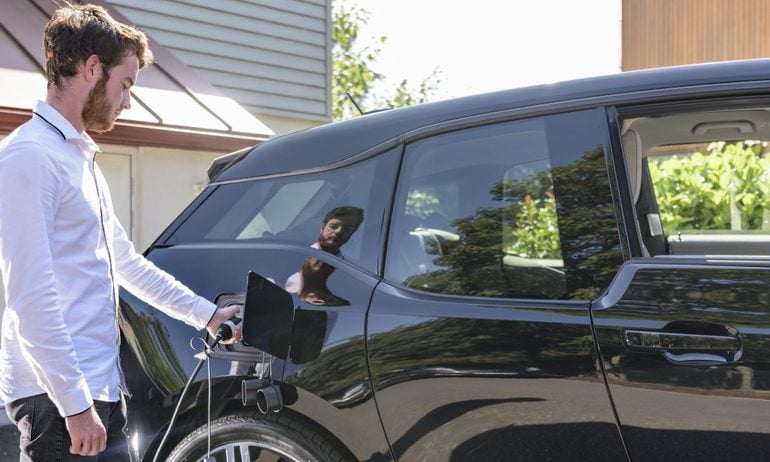How to Charge Your Electric Vehicle at Home
In most cases, installing Level 2 charging at home is worth the cost.

Many, or all, of the products featured on this page are from our advertising partners who compensate us when you take certain actions on our website or click to take an action on their website. However, this does not influence our evaluations. Our opinions are our own. Here is a list of our partners and here's how we make money.
EV owners have two options for electric car charging at home.
Plug into a standard wall socket. This method, called Level 1 charging, is easy and doesn’t require extra equipment, but it will only add a few miles of range per hour of charging.
Invest in a Level 2 charger. This gives you the ability to add hundreds of miles in a single charging session, like when you’re parked overnight. It accomplishes the same thing as a Level 1 charger — moving electrons from the grid to your vehicle — but does so at a higher rate, like a fire hose compared to a garden hose.
Buying a Level 2 charger and hiring an electrician to run a sufficiently powerful line could cost up to a few thousand dollars, but the upfront cost could be worth it for the ability to charge faster. Plus, there are ways to minimize the cost of an EV home charger.
How much faster is Level 2 charging?
Level 2 charging adds about 25 miles per hour of charging. That’s at least five times faster than the typical Level 1 charger. If your car spends at least eight hours at home on the average day, you can count on at least 200 miles of range added daily.
Level 1 charging adds about five miles per hour. It can seem sluggish by comparison, like having a slow internet connection after you’ve experienced gigabit speeds. If you leave your car plugged in for eight hours, expect to gain about 40 miles of range.
Explore the auto-buying platforms from our partners below.
AD
How much does it cost to install a Level 2 charger?
First, you’ll need the charger itself. If you don’t already have one, plan to spend between $400 and $1,000, depending on the type of charger you choose. Level 2 chargers are largely interchangeable among different makes and models, so you can shop around for the features and price point you want. In addition to buying directly from charging companies, you can shop at major hardware and electronics stores. If you own a Tesla, which uses a proprietary connector, you have fewer options.
Next, you’ll need a 240-volt connection to plug into. Most homes don’t have this connection where they plan to charge, though you might find one in a kitchen or laundry area — some electric ovens or clothes dryers run on them.
Installing a 240-volt line requires a professional electrician. This can cost up to a few thousand dollars, depending on your situation. For example, running a connection from an electric panel in a basement to a freestanding garage will likely be more expensive than in a location where the electric panel is in the garage.
Once the line is installed, one option is to install an outlet and plug the charger in. Another option is to hardwire the charger directly to your home’s electric system, eliminating the need for an outlet.
If you don’t have a garage or prefer to charge outdoors, Vlad Savine, master electrician at United Chargers, says he usually recommends hardwiring the charger, which means the device will be tied directly into your home’s electric system, bypassing the need for an outlet. Even if you plan to only charge indoors, however, it might be worth considering hardwiring your Level 2 charger. While it can add to the cost and you lose the flexibility to easily move it later, it’s often more capable of handling the high demands of charging a car.
If you’re unsure of your home’s electrical capabilities, an electrician can help and should be able to provide options in the event that your electrical system doesn’t meet the needs of your preferred charger.
Is adding Level 2 charging to a home worth the cost?
The best charger for you depends on your vehicle and your driving habits. Savine says the size of a vehicle’s battery, which varies greatly from vehicle to vehicle, is one consideration. For smaller batteries, you may never need the higher speeds of Level 2 charging. For instance, the Nissan LEAF’s 40-kilowatt-hour battery has less than half the capacity of the 91-kWh extended-range battery in the Ford Mustang Mach-E Premium, so the time it needs to charge completely is also less.
Plug-in hybrid electric vehicles, or PHEVs, have batteries that can power a few dozen miles — enough to get through the average day. They also have a gas engine that kicks in on longer drives. One such car, the Toyota Prius Prime, has an 13.6-kWh battery that charges completely in about 11 hours on a standard outlet.
However, if your EV has a larger battery, if you often drive more than 40 miles per day, if you don’t live near a reliable commercial charger or if you value the convenience of charging quickly, adding a Level 2 charger to your home is worth considering.
Are there ways to save money on Level 2 chargers?
Yes. Some car manufacturers include free installation of a 240-volt outlet and a Level 2 charger if you buy or lease a new EV. If you’re shopping for a new car, check to see what offers are available.
You can also search the U.S. Department of Energy’s website to find federal, state or local EV incentives specific to where you live.
What does it cost to charge an EV at home?
Whether you use Level 1 or Level 2 charging at home, you’ll pay for the electricity you use. The national average per kWh was about 17 cents in November 2024, according to the U.S. Energy Information Administration. At that price, a car with a 50-kWh battery would cost $8.50 (50 × $0.17) for a complete charge.
Your rate could be higher or lower depending on where you live, time of year and the time of day you charge. To save money, review your electric rates to see if charging during one part of the day is less expensive than another.
Which charger is best?
Take these steps to help find the best Level 2 charger for your home.
Consult your owner’s manual. Although Level 2 charging standards are generally universal, some manufacturers, like Tesla, use different equipment. Older models or EVs with small batteries might have different requirements.
Inspect your charging area. If your charger will be outdoors, you’ll want something that can handle the weather. How far will your car usually be from the charger? Not all cords are the same length.
Research app compatibility. Just like a smart thermometer helps optimize a home’s HVAC system, apps that power chargers can help manage your car’s charge. This might mean charging when your electric rates are lowest or managing your charging schedule from your phone. But the software in your car might not mesh well with the charger software, according to Savine. If you’re wondering whether the charger-EV combo you have in mind will work well, check online message boards to see if anyone has recently posted about their experience.




